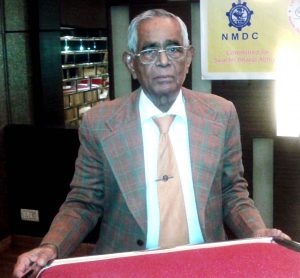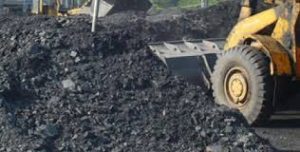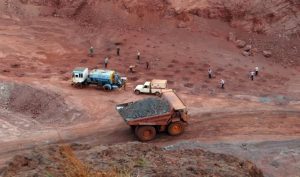P rof. Dr. P. K. Jena in Bhubaneswar, August 12, 2022: Mineral is one of the most important natural resources. The mineral resource is being mined and utilized for meeting our increasing needs of energy, metals and alloys, cement, refractories, pigments, inorganic chemicals and many others.
rof. Dr. P. K. Jena in Bhubaneswar, August 12, 2022: Mineral is one of the most important natural resources. The mineral resource is being mined and utilized for meeting our increasing needs of energy, metals and alloys, cement, refractories, pigments, inorganic chemicals and many others.
The socio economic developments of the present world have been possible mainly because of this resource. However, the mineral resource being non renewable in nature and being used on large scale is getting exhausted very fast in recent decades.
It is apprehended that, unless effective measures are taken to conserve and utilize all grades of this resource judiciously, our industrial and socio economic progress would slow down very significantly.
In order to make these developments sustainable, it is necessary to manage mineral resources properly using environment friendly technologies with zero waste approach.
Industries in areas of production of thermal and nuclear power, iron and other metals and their alloys, special materials, cement, inorganic chemicals and refractories, are all mineral based.
During the last half century or so, extensive mining of minerals and upgradation of low and complex ones, have been taking place in mine areas disrupting the earths crust, destroying a lot of vegetations and polluting the land, water bodies and air to a great extent.
In addition to these, during utilization of minerals in thermal, metallurgical, chemical, cement and refractories industries, huge quantities of solid wastes, liquid and gaseous effluents are being generated.
Large amounts of wastes and effluents like tailings and washery slimes produced during upgrading low grade coal, ores of iron, manganese, copper etc., the fly ash produced during thermal power generation, the red mud generated during alumina production from bauxite and the slags and leached residues produced during metal extraction are affecting considerably the human settlements, the vegetation, water bodies and also create a lot of environmental problems.
 For example, nearly 1 ton (T) of fly ash for every 2.5 T of coal consumed in thermal power plant, about 2.5 T of red mud for producing 1 T of aluminium from bauxite and about 200 T of tailings in production of one ton of copper from its ore, are being generated and are dumped on land and in water bodies creating a lot of environmental pollution and destroying land, forest and water resources.
For example, nearly 1 ton (T) of fly ash for every 2.5 T of coal consumed in thermal power plant, about 2.5 T of red mud for producing 1 T of aluminium from bauxite and about 200 T of tailings in production of one ton of copper from its ore, are being generated and are dumped on land and in water bodies creating a lot of environmental pollution and destroying land, forest and water resources.
The major mineral based industrial wastes like slags, red mud, fly ash and slimes and tailings of mineral processing units pose huge environmental problems globally.
In recent years, due to enforcement of various environmental rules and regulations and also because of need for conserving the limited mineral resources, it has been somewhat mandatory to develop techno-economically viable processes to treat industrial wastes and convert these into resources.
In order to judiciously utilize the non replenishable vital mineral resources, with zero waste approach, it is essential to take the following measures for their conservation and judicious utilization.
- Adopting scientific mining practices to harness all grades of minerals,
- Upgradation of lean and complex minerals,
- Agglomeration of mineral fines and mineral concentrates after upgradation,
- Utilization of wastes of thermal power plants,
- Utilization of wastes of metal extraction plants and other industrial and domestic metal containing wastes.
Adoption of Scientific Mining Practices to harness all grades of Minerals
 Mining of minerals should be planned in a very scientific and integrated manner so that, different grades of minerals are mined as selectively as possible without damaging other resources like water and forest.
Mining of minerals should be planned in a very scientific and integrated manner so that, different grades of minerals are mined as selectively as possible without damaging other resources like water and forest.
Modern mining technology has to be adopted to obtain the mineral resources present in the mines, as much as possible.
The low grade minerals as well as the less important minerals available along with the main minerals which cannot be extracted economically at present, should be preserved properly so that, these can be used at a later date when the processes become economically viable.
Upgradation of Lean and Complex Minerals
The reserves of high grade minerals are much less compared to those of medium and low grade ones. Further, in some cases, more than one metals are present in the mineral body in appreciable quantities which need to be processed and recovered.
While utilizing the high grade minerals as such, the lean ones should be either suitably blended with the high grade one or should be up-graded through various physico chemical processes for their further use in metallurgical, thermal, refractories and chemical industries.
In recent years, various upgradation techniques have been developed and used to up-grade low grade coal, iron ore, chromite, manganeseore, etc.
Agglomeration of mineral fines and mineral concentrates after upgradation
Large quantities of mineral fines are generated and get accumulated at mine sites mostly due to mechanized mining. In addition to this, the fragile nature of some of the minerals like chromite also result in high percentage of fines during mining.
Further, the low and medium grade minerals which comprise major fraction of the reserves, have to be upgraded resulting in a lot of fine concentrates. Substantial amount of ultra fine mineral concentrates can also be recovered from the mineral washery slimes.
All these fines from various sources have to be agglomerated before these are used in metallurgical and refractory industries. These are to be agglomerated either by sintering, pelletization or briquetting.
Out of these three processes of agglomeration, the sintering is considered to be most economical. For example, most of the iron ore fines are sintered to be charged in the blast furnace along with the lumpy ores or as such to produce iron.
Sinters are considered to be better raw materials from the reduction kinetics point of view.U
Utilization of Wastes of Thermal Power Plants
 All over the world, thermal power plant is the single major power producer accounting for about 55% of the total electrical energy generated. Extensive research and development work in different parts of the world, have been taken up in recent years to utilize most of the fly ash generated as waste in coal based power plant.
All over the world, thermal power plant is the single major power producer accounting for about 55% of the total electrical energy generated. Extensive research and development work in different parts of the world, have been taken up in recent years to utilize most of the fly ash generated as waste in coal based power plant.
Fly ash can be utilized for producing good quality cement, bricks, building blocks, agglomerates, concrete mixtures, filling up mine voids and low lying areas, developing embankments and also in improving the soil fertility.
It is reported that, in developed countries, most of the fly ash is utilized in these ways, but in India only 20 to 30 pct. of the ash generated is being utilized at present and the rest is being dumped in ash ponds or as ash heaps.
Clay fly ash bricks, calcium silicate fly ash bricks, cellular concrete, small quantities of fly ash in cement making, fly ash lime gypsum bricks (FaL-G), sintered light weight aggregates etc, are some of the potential items which can be utilized in building and road construction activities and thus consuming considerable amounts of fly ash.
Utilization of Wastes of Metal Extraction Plants as well as other industries and domestic wastes
In metal extraction processes, a lot of wastes like slags, flue dusts, leached residues, sludge etc. containing a lot of mineral values are generated.
These need to be processed to recover the metal values. In addition to this, the rejected metal containing items from other industrial as well as domestic sectors should be collected and the metals should be recovered by different suitable processes.
Mineral resources are very essential for socio economic developments of human society. Most of the present practices of unscientific mining of minerals and their subsequent utilization in various sectors have resulted in loss of appreciable amounts of mineral values.
In order to sustain our economic developments we have to apply best available environment friendly technology for harnessing the minerals as well as utilizing these for various purposes with zero waste approach. Some of the steps to be undertaken in this regard are as follows:
- Constant efforts should be made to locate new reserves of mineral resources in the earth crust and utilize advance technologies for mining these to the fullest extent with minimum damage to other resources like water bodies and forests.
- All grades of minerals should be mined and the low grade ones to be upgraded to make these suitable for their subsequent use in various mineral based industries.
Advance environment friendly technologies should to be applied for utilizing these resources either for generating energy or extracting the metal values or producing other mineral based products with zero waste approach. - Various efforts should be made not only to utilize the wastes but also minimize their generation and recycling the wastes with or without prior treatment as far as possible.
Efforts should be made to recover the metal values from the secondary sources like spent catalyst, scraps, e-waste etc. - In the process of utilising the mineral resources for our socio economic benefits, we have to avoid environment pollution and maintain an eco-friendly atmosphere.
- Former Director General, Council of Scientific & Industrial Research, India


Leave a Reply
Be the First to Comment!